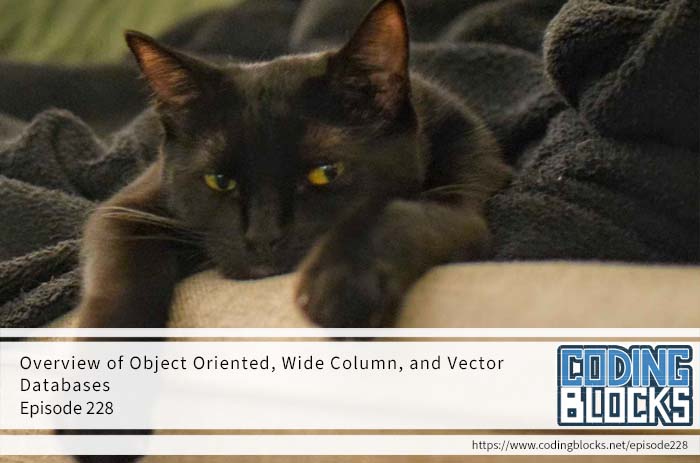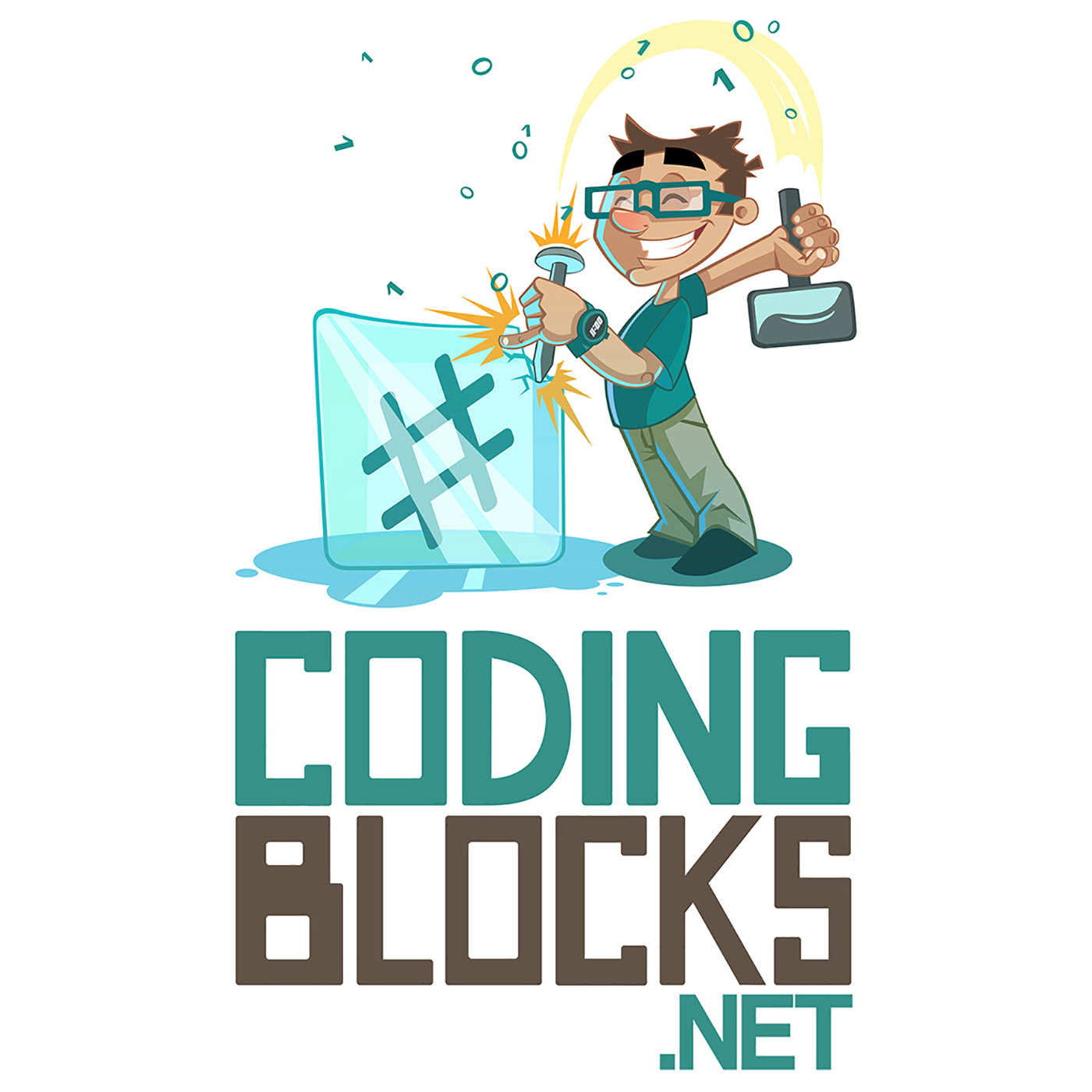Overview of Object Oriented, Wide Column, and Vector Databases
Update: 2024-02-19
Description


We have a different combination of the hosts for this episode where we continue the series on the types of database systems available and why you might choose one over another. Michael continues impressing by recalling everything we’ve ever said on our 500+ hours of podcasts, Allen enjoys learning about a database system he’d never come across, and Joe is loaded up and ready for his trek to Georgia, USA.
Reviews
- iTunes: Calum55555
- Spotify: Ian Neethling, Ghostmerc, Xuraith
- Audible: Wood2prog
News
Orlando Code Camp
https://orlandocodecamp.com/
Object Oriented DBMS
- Popular: InterSystems Cache, 92. InterSystems IRIS, 161. DB4o, 154. ObjectStore, 159. Actian NoSQL Database
- The idea was to store data in the database the way that it’s modeled in the application
https://stackoverflow.com/questions/9884407/what-is-the-difference-between-object-oriented-and-document-databases#:~:text=The big difference%2C that I,but they’re organized differently. - Relationships and inheritance would also be modeled in the database
- Would be more performant because the data would be stored in the way the application would expect without using complex joins
- Fallen out of popularity with the availability of ORM’s for RDBMS
https://www.ionos.com/digitalguide/hosting/technical-matters/object-oriented-databases/ - From InterSystems IRIS info
- Based on the ODMG (Object Database Management Group) standard with advanced features like multiple inheritance
- ObjectScript and Python directly manipulate and read from the storage – objects can also be exposed in other languages like .NET, JavaScript, Java and C++
- Can also be queried with SQL syntax
Wide Column Stores
- Popular: 12. Cassandra, 26. HBase, 27. Azure Cosmos DB
- Also known as extensible record stores
https://static.googleusercontent.com/media/research.google.com/en//archive/bigtable-osdi06.pdf - Can hold extremely large numbers of dynamic columns
- How much is a large number – “a record can have billions of columns” – which is why they’re also described as two-dimensional key/value stores
- Schema on read
- Wide column stores should not be confused with columnar storage in RDBMS – the latter is an implementation detail inside a relational database system that imroves OLAP type of performance by storing data column by column rather than record by record
- Using Cassandra as the information – https://cassandra.apache.org/_/cassandra-basics.html
- Hyper-horizontally scalable
- Prevents data loss due to hardware failures (if scaled)
- Ability to tweak throughput of reads or writes in isolation
https://www.codingblocks.net/podcast/search-driven-apps/ - It’s “distributed” manner means it runs on many nodes but it looks like a single point of entry
- No real point of running a single node of Cassandra
- “Masterless” architecture – every node in a cluster acts like every other node
https://www.codingblocks.net/podcast/designing-data-intensive-applications-secondary-indexes-rebalancing-routing/ - In contrast with traditional RDMBS – can be scaled on low-cost, commodity hardware – don’t need super-high-end motherboards that support terrabytes of ram to scale
- Linear scalability – every node you add gives you + n throughput
https://www.datastax.com/products/datastax-astra - Replication is handled by tweaking replication factors – ie how many times you want the data replicated in order to stay in a good state
- Per query configurable consistency – how many nodes must acknowledge the read/write query before returning a success
- Hyper-horizontally scalable
Vector DBMS
- Popular: 52. Kdb, 103. Pinecone, 139. Chroma
- A database system that specializes in storing vector embeddings and being able to retrieve them quickly
- What is a vector embedding?
- https://www.pinecone.io/learn/vector-embeddings-for-developers/
- What is a vector? A mathematical structure with a size and a direction
- Think of it as a point in space (on a graph) with the direction being the arrow from (0,0,0) to the vector point
- They say for developers, it’s easier to think of vectors as an array of numbers
- When you look at the vectors in space, some will be floating by themselves while others might be clustered closely to each other
- Vectors are very useful in Machine Learning algorithms because CPUs and GPUs are very good at doing math
- Vector Embeddings is the process of converting virtually any data structure into vectors
- It’s not as simple as just a straight conversion
- You don’t want to lose the original data’s “meaning”
- An example they used was comparing two sentences – you wouldn’t just compare the words, you want to compare if the two sentences had the same meaning
- To keep the meaning and produce vectors with relationships that make sense, that requires embedding models
- Nowadays, many embedding models are created by passing large sets of “labeled” data to neural networks
https://en.wikipedia.org/wiki/Neural_network- Neural networks are trained using supervised learning (usually), they can also be self-supervised or unsupervised learning
- Using a supervised model, you pass in large sets of data as pairs of inputs and labeled outputs
- The values are transformed in each layer of the neural network
- With each training of the neural network, the activations at each layer are modified
- The goal is that eventually the neural network will be able to provide an output for any given input, even if it hasn’t seen that specific input before
- The embedding model is essentially those layers of the neural network minus the last one that was labeling data – rather than getting labeled data you get a vector embedding
- Neural networks are trained using supervised learning (usually), they can also be self-supervised or unsupervised learning
- They have a great visualization on the pinecone page showing the output of a word2vec embedding model that shows how words would appear in this 3d vectror space
- This is what an embedding model does – it can take inputs and know where to place them in “vector space”
- Items placed closer together are more related, and further apart, less related
- You don’t want to lose the original data’s “meaning”
- What is a vector embedding?
- Ok, so now we know what vector embeddings are, what can we do with them?
- Semantic search – rather than having search engines be able to search for words that are similar to what you entered, they can now search for content with meaning similar to what you searched for
- Question answering applications
- Audio search
- Check out the page of sample applications – https://docs.pinecone.io/page/examples
Resources
- Primary resource we used for these database rankings
https://db-engines.com/en/ranking - Some nice ways to learn about Machine Learning in an approachable way
https://scikit-learn.org/stable/tutorial/machine_learning_map/index.html
Tips of the Week
- docker init – let AI help you generate a better Dockerfile
https://medium.com/@akhilesh-mishra/you-should-stop-writing-dockerfiles-today-do-this-instead-3cd8a44cb8b0 - epoch converter has code samples!!!
https://www.epochconverter.com/ - Add a someone you trust as an
Comments
In Channel





